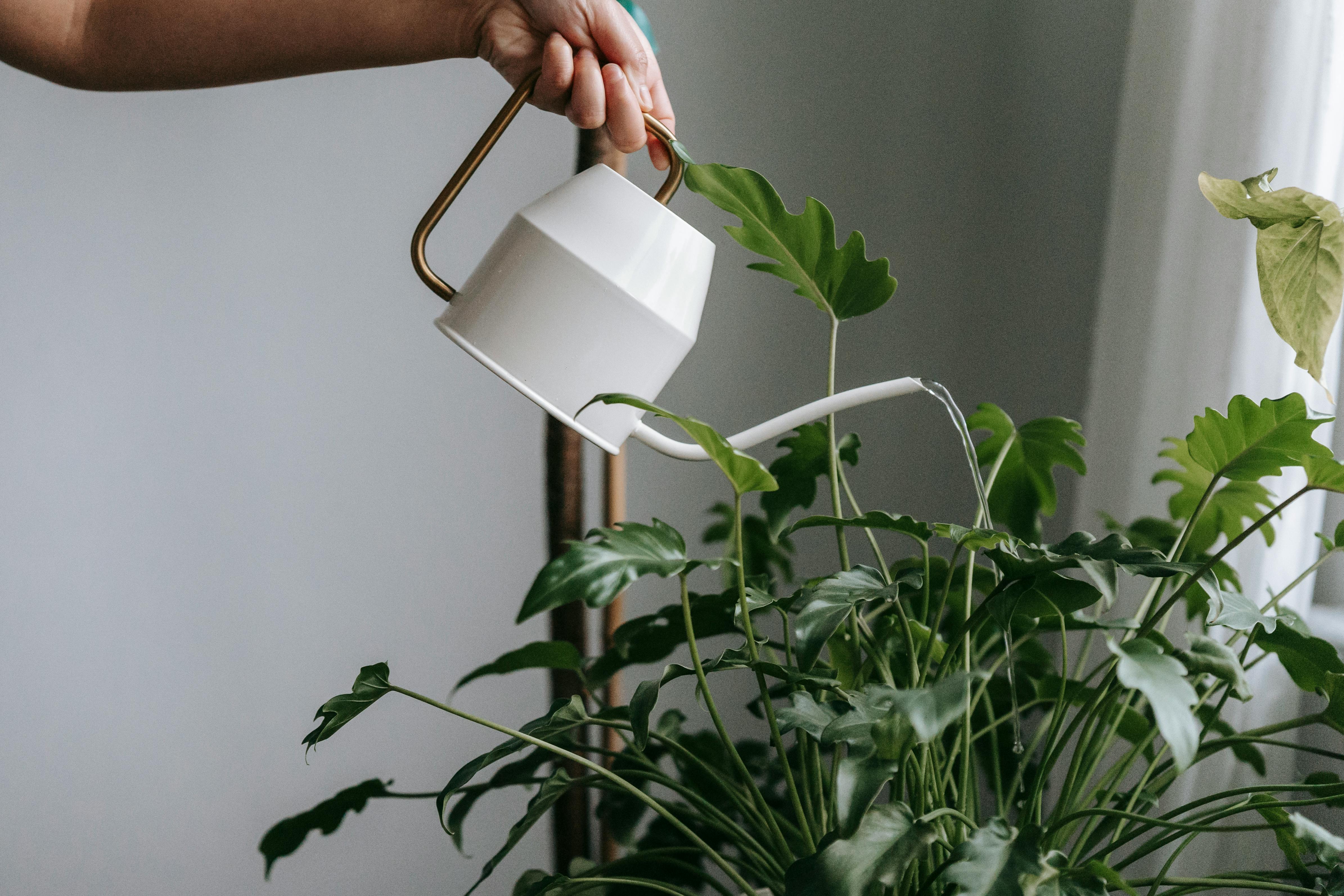water/” title=”Can Alocasia Grow In Water”>Alocasia, sometimes called Elephant Ears, is a beautiful and exotic type of plant that is native to tropical regions. They are known for their large, arrow-shaped leaves and stunning colors. Many people wonder if it is possible to grow Alocasia in water. The answer is yes! With some knowledge of the care requirements and a few supplies, you can successfully grow Alocasia in water.Yes, Alocasia can be grown in water. It is easy to propagate the plant in a water-filled container and will continue to grow. It is important to change the water regularly and provide the plant with enough light and nutrients.
Alocasia
Alocasia is a genus of broad-leaved rhizomatous or tuberous perennials from the family Araceae. They are native to tropical and subtropical regions of Asia and the Pacific Islands, with most species occurring in Southeast Asia. The genus is characterized by its large, waxy leaves that come in a variety of shapes, sizes, and colors. Alocasia plants are also known for their attractive flowers that appear in shades of white, pink, or yellow.
Alocasia plants are often grown as houseplants because they require minimal care and can tolerate low light levels. They prefer rich, well-draining soil and regular watering but should be allowed to dry out between waterings. Most species of Alocasia require some humidity to thrive, so it is important to keep the soil moist or mist the leaves regularly.
These plants need plenty of bright light for optimal growth, but direct sunlight should be avoided as it can cause leaf scorching. They also benefit from occasional fertilization during the growing season to ensure healthy growth and vibrant foliage coloration.
Propagation of Alocasia plants can be done by division or from seed. When propagating from seed, it is important to ensure that the seeds are fresh and stored correctly before planting them in moist soil. Seeds should be planted about 1/2 inch deep and kept at a temperature of around 70°F for best results.
Overall, Alocasia plants are a beautiful addition to any home or garden due to their striking foliage and attractive flowers. With proper care and maintenance, these plants can thrive indoors or outdoors for many years and bring a unique beauty to your space!
Requirements for Growing Alocasia in Water
Growing Alocasia in water is a great way to bring a green and vibrant touch to your home. It is easy to care for and provides a beautiful, lush look. There are a few requirements for growing these plants in water successfully, however. Here are the basics you’ll need to know to get started:
The first step is to make sure you have the right type of potting soil. Alocasia plants prefer soil that is slightly acidic and drains well. If your soil does not drain properly, it can become waterlogged and cause the roots to rot. You may need to add some peat moss or compost to improve the drainage.
Next, you’ll need to choose the right container for your plant. A glass jar or vase works well, as it allows you to monitor the water level and easily adjust it when necessary. Be sure that the container is large enough for your plant’s root system and has drainage holes at the bottom so excess moisture can escape.
Finally, you’ll need to select the best type of water for your Alocasia plants. Tap water usually contains chlorine or other additives which can be harmful to plants, so filtered or distilled water is best if possible. If that isn’t an option, let tap water sit out overnight before using it on your plants.
With these tips in mind, you’re ready to start growing Alocasia in water! Once you have everything set up correctly, all that is left is maintaining ideal conditions for your plant’s growth and health by providing adequate sunlight and watering when needed.
Benefits of Growing Alocasia in Water
Growing Alocasia in water has many benefits. It is an easy way to propagate and maintain a healthy Alocasia plant. The process does not require soil or other growing mediums, and is simple enough for novice gardeners to try. Plus, it is a great way to show off the beauty of the Alocasia leaves as they sit in a decorative container.
The main advantage of growing Alocasia in water is that it prevents root rot, which can be caused by over-watering or poor soil drainage. When the roots are constantly submerged in water, they are able to absorb just the right amount of moisture without becoming saturated. This helps the plant stay healthy and vigorous without any extra effort from its owner.
Another benefit of growing Alocasia in water is that it allows gardeners to easily monitor and control the amount of nutrients in the plant’s environment. By adding fertilizer directly into the water, gardeners can provide their plants with all the nutrients they need without having to worry about overdoing it. This makes it much easier for a gardener to create an ideal environment for their plants with minimal effort.
Finally, growing Alocasia in water can also save space for gardeners who may not have enough room for a large outdoor garden. When grown inside, these plants do not require as much space as other types of houseplants since all that’s needed is a small container or bowl filled with water. This makes them ideal for apartments or other small living spaces where outdoor gardening may not be possible.
In summary, there are many benefits to growing Alocasia in water rather than soil. Not only does this prevent root rot, but it also makes it easier to provide necessary nutrients and conserve space indoors. For these reasons and more, growing Alocasia in water is an ideal solution for novice and experienced gardeners alike.
Soil Requirements
When it comes to growing Alocasia in water, the soil requirements are of utmost importance. You will need to use a soil that is well-draining and has a high organic content. This will help to ensure that the Alocasia is able to get enough oxygen and nutrients from the water. Additionally, you should avoid using potting mixes that contain peat moss or other types of synthetic materials, as these may not be suitable for growing Alocasia in water.
Water Quality
In addition to the soil requirements, you will also need to be mindful of the quality of the water you are using for your Alocasia. You should try to use clean, filtered water if possible, as this will help to ensure that your plant gets all of the necessary nutrients it needs. Additionally, you should try to avoid using tap water that contains chlorine or other chemicals, as this can be harmful for your Alocasia.
Light Requirements
When it comes to light requirements for growing Alocasia in water, you should provide your plant with plenty of indirect sunlight. If possible, place your plant near a window where it can receive at least 4-6 hours of light each day. Additionally, if you live in an area with very hot summers, you may want to consider providing some shade during those months so that your plant does not become overheated.
Temperature
The ideal temperature range for growing Alocasia in water is between 65-75 degrees Fahrenheit (18-24 degrees Celsius). It is important to keep an eye on the temperature when growing this type of plant, as temperatures that are too high or too low can cause problems such as wilting or stunted growth.
pH Levels
The pH level of the water used for your Alocasia should be between 6.0 and 7.5. If the pH level is too high or too low it can cause problems such as nutrient deficiencies or yellowing leaves.
Fertilization</h20
It is also important to fertilize regularly when growing Alocasia in water. You will want to use a fertilizer specifically formulated for aquatic plants and follow the instructions on the package for best results. This will help ensure that your plant receives all of the necessary nutrients it needs for healthy growth.<

Preparing the Soil for Planting Alocasia
When planting Alocasia, it is important to prepare the soil beforehand. The soil should be rich in organic matter and well-draining to ensure that the plant has all the nutrients it needs to grow and thrive. Alocasia prefers a slightly acidic soil with a pH between 5.5 and 6.5. To achieve this, you can mix compost or peat moss into the existing soil prior to planting. It is also important to make sure that any fertilizer applied is balanced and not too high in nitrogen, as this can cause leaf burn. Adding a slow-release fertilizer at the time of planting can help provide ongoing nutrition for your plant.
Once the soil has been prepared, it is time to plant your Alocasia. Planting should be done in spring or summer when temperatures are warm enough for root growth. Make sure that the root ball is covered with soil up to its original level; any higher may cause stem rot due to too much moisture retention around the stem area. After planting, water thoroughly and check for signs of wilting or yellowing of leaves; these indicate that more watering may be required.
Types of Containers for Planting Alocasia in Water
When it comes to planting Alocasia in water, the type of container you use is crucial. Alocasia like to have their roots submerged in water and need a container that has adequate drainage. Popular containers for growing Alocasia in water include glass jars, ceramic or terracotta pots, ceramic bowls and even glass bottles.
Glass jars are one of the most popular containers used for growing Alocasia in water. They are easy to find and come in a variety of sizes, making them perfect for this type of project. The key is to make sure that the jar has enough drainage holes at the bottom so that the water can drain away from the roots of the plant.
Ceramic or terracotta pots are also great for growing Alocasia in water as they provide ample drainage as well as an attractive look. These containers come in a variety of shapes and sizes, so you can choose one that is best suited for your particular project. It’s important to note that terracotta pots will need to be sealed with waterproof sealant before using them for planting, as they are porous and can absorb moisture from the soil.
Ceramic bowls are also popular options when it comes to growing Alocasia in water. They come in a variety of sizes and shapes, so you can easily find one that fits your needs perfectly. As with other types of containers, ceramic bowls should be sealed with waterproof sealant before being used for planting as they absorb moisture from the soil easily.
Finally, glass bottles can also be used to grow Alocasia in water if you’re looking for something unique and attractive. The key is to make sure that the bottle has enough drainage holes at the bottom so that the water can drain away from the roots of the plant properly. Additionally, you may want to consider placing rocks at the bottom of your bottle before adding soil and plants to increase drainage if necessary.
How to Plant Alocasia in Water
Planting Alocasia in water is an easy and fun way to add a tropical flair to your home. The most important thing to remember is that you should use distilled or rainwater for the best results. Begin by selecting a pot that is at least six inches deep and has drainage holes. Fill the pot with moist, well-draining soil and then place your Alocasia rhizome in the soil. Cover it with two inches of soil and lightly press down so that the rhizome is secure. Water your Alocasia until it is saturated, but be careful not to overwater. Finally, place the pot in a warm area of your home that receives indirect sunlight.
Caring for Alocasia in Water
Caring for Alocasia in water is fairly straightforward once you have planted it correctly. It’s important to keep the soil moist but not soggy at all times, so check on it every few days and water as needed. You may also want to fertilize your Alocasia every two weeks with a liquid fertilizer specially formulated for houseplants. Be sure to follow the instructions on the package for optimal results. Additionally, you should keep an eye out for any pests such as aphids or mealybugs, which can be treated with insecticidal soap or neem oil if necessary.

Conclusion
Alocasia can be grown in water with great success, given the right conditions. Planting in soil is still recommended for long-term stability, but with proper attention and maintenance, Alocasia can thrive in water. Watering should be done on a regular basis, and the water should be regularly changed to avoid build-up of toxins. The use of fertilizer is not necessary when growing Alocasia in water. With the correct care and maintenance, Alocasia will continue to flourish in its aquatic home.
Ultimately, whether or not to grow Alocasia in water is a personal decision. Some gardeners may prefer to plant their Alocasia directly into soil while others may opt for a more unique growing method. As long as the right conditions are provided, both methods can yield successful results.

